Agriculture Reference
In-Depth Information
Figure 5.13
Old Shiraz vines that survived phylloxera in the 19th century on a sandy ridge in
the Nagambie subregion, Victoria, Australia. (White, 2003)
Because insecticides are ineffective in controlling phylloxera, the best method
of long-term control is to use cultivars that are grafted onto resistant rootstocks.
Control in planting material (cuttings and rootlings) is achieved by hot-water
treatment, which is also used to control nematodes, crown gall, and phytoplasma
disease (see box 2.5, chapter 2). Rootstocks with
V. vinifera
parentage should not
be used when strong resistance to phylloxera is required. Table 5.8 summarizes the
phylloxera resistance of the more widely available rootstocks.
Nematodes and their Control
Although more than 60 species of plant-parasitic nematodes have been recorded
on grapevines, many of these may have been associated with cover crops in the
vineyards. Box 5.4 describes the more serious pest nematodes of grapevines.
Nematodes feeding on or invading roots cause malformations and necrosis.
Infested vines suffer reduced root function and loss of vigor, without any specific
above-ground symptoms. Nematode damage is more severe in sandy soils. Overall,
nematodes are a more serious problem than phylloxera in many Australian viti-
cultural regions, especially in the sandier soils of the Murray Valley, which favor
nematode survival and attack.
As discussed in “Preplanting” in chapter 2, fumigants are effective nemati-
cides, especially in replant situations or where crops such as potatoes or tomatoes
that harbor nematodes have been grown for several years (most nematodes infect-
ing grapevines can attack other host plants). However, the effect of fumigation is

